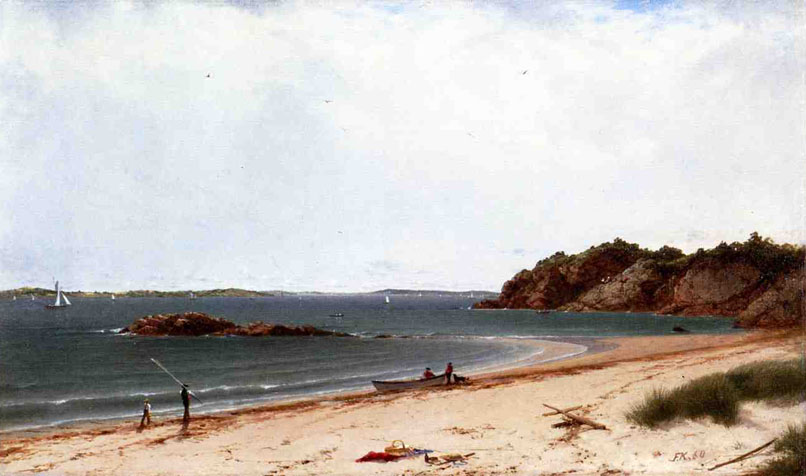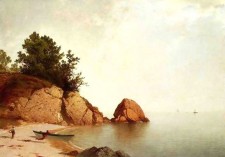
John Frederick Kensett
American, 1816-1872
View of the Beach At Beverly, Massachusetts, 1860
oil on canvas
14 1/4 x 24 1/4 in.
SBMA, Gift of Mrs. Sterling Morton to the Preston Morton Collection
1960.68

Kensett painting in his studio, next to an easel, photographer unknown, ca. 1866.
At a meeting of the Century Association in Kensett's memory in December 1872, one of his many eulogists observed perceptively that the artist's "profession served only as a finer background for the calmness and equilibrium and sweetness of his personal habits, while his fine moral qualities entered into his works, sobered his judgment and chastened his style."
RESEARCH PAPER
The seascape "View of the Beach at Beverly, Massachusetts", painted in 1860, an oil on canvas, represents a refined distillation of John Frederick Kensett's artistic talent and luminist style. Luminism meant depicting a clear atmosphere, a quiet presence, with painstaking attention to detail. The peaceful quiet harmony of man, earth, sky and sea embody some ideas of the Hudson River School, coupled with the influence of American's feeling of Manifest Destiny, which affected much of the landscape painting in this country in the 19th Century and Kensett's in particular.
The subject of the painting is north of Boston in Beverly, at Plum Cove, looking out across the cove to the shores of Marblehead and Salem, Massachusetts. Kensett thoroughly studied and sketched the surroundings of his works before he began painting, often painting different views of the same setting. In this case, Kensett painted another view of this same particular beach, which was subsequently destroyed. (1) Looking closely at " View of the Beach at Beverly, Massachusetts ", we see the clarity of minute detail, which refer to Kensett's experience as an engraver. The blades of grass in the foreground, the clothing of the young fisherman, the seagull hovering above the cove, and the shadows of the boats shimmering in the distant water, are examples of this distinctive clarity. The horizontal plane and pastel palette give a calm, reflective quality, which isolates the moment on canvas. Symbolically, the piece of crossed wood in right foreground, the vast uplifting sky, and nature depicted in flawless perfection, connotes religious romanticism. (2) The grass, small figures and boats, rippling waves and bright clouds with breaking sky, move our eye across this asymmetrical setting. Man and his activities are represented in small scale, not detracting from this pristine setting. The work is divorced from the nation's division over the slavery issue, imminent civil war and the fact that the cities were bursting with immigrants from England and Ireland. This, and other works like it, were in popular demand at this time.
Kensett is considered a second-generation Hudson River School painter, not as allegorical as Thomas Cole who thought, "landscapes without spiritual meaning were useless", (3) but more like his contemporary Asher Durand who sought to imitate the truth in nature. As Kensett refined and abstracted his landscape painting in the 1850's, he developed his own style of creating a harmony between man and the landscape. In the 1860's, his subject turned to seascape and his dark rich palette became more pastel. Man became smaller and more insignificant until in the last stage of his painting, which is pure seascape known as the Last Summer Work, Kensett eliminated man depicting religious and philosophical meaning in the pure unspoiled land and seascape.
John Frederick Kensett was born in Connecticut in 1816, the son of an engraver. He began his artistic career as an engraver of bank notes and book covers. At the age of 24 he traveled with friends John Casilear, Asher Durand, and Thomas Rossitter to Europe to study not only engraving but also painting. The stay in Europe lasted seven years and there he admired the landscapes of Constable and H.T. Boddington as well as the classical landscapes of Claude Lorrain. By 1847 Kensett was ready to return to the American landscape and soon after his return enjoyed success, which followed him until his untimely death in 1872. His popularity as a gifted painter was enriched by his close association with friends like Thomas Cole, Asher Durand, Fredrick Church, Albert Bierstadt and others including literary figures Henry W. Longfellow, Charles Dana, William Cullen Bryant and Oliver Wendell Holmes.
Kensett was well liked by his contemporaries and it was said in his day that this gentle goodness shone through his work. His life exemplified the same goodness as he dove into icy water to retrieve the body of his friend's wife when others stood watching. It was this act that resulted in Kensett's death from pneumonia in 1872 at the age of 56. This statement was made at a memorial service, "There is hardly a parlor, or a private or public gallery in our city (New York) ... or in the country, that does not contain one or more of the productions of Mr. Kensett's hand". (4) His relatively early death spared Kensett the anxiety of seeing his work hidden away from public view and almost forgotten which was an experience that both Church and Bierstadt suffered through. It was almost one hundred years before they all would be appreciated for their genius in the treatment of the American landscape.
"View of the Beach at Beverly, Massachusetts" was donated to the Santa Barbara Museum of Art by Mrs. Sterling Morton, to the Preston Morton Collection with general restrictions concerning light and humidity. The work received a general cleaning in 1981 at the Los Angeles County Museum of Art and has since been loaned with some frequency.
Prepared for the SBMA Docent Council by Susan Skenderian, March 20, 1992
Bibliography
Bennewitz, Kathleen Motes. John F. Kensett at Beverly, Massachusetts. The American Art Journal/Volume XXI, November 4, 1988.
Driscoll, John Paul. and Howat John K. John Frederick Kensett An American Master . New York. W.W. Norton Company. 1985.
Howat, John H. John Frederick Kensett 1616 - 1872 . New York. American Federation of Arts. 1968.
Howat, John H. and Spassky, Natalie. Nineteenth Century America . New York. The Metropolitan Museum of Art. 1970.
Lynes, Russell. The Art-Makers of Nineteenth Century America . New York. Kingsport Press, Inc. 1970.
Footnotes
1. Kathleen Motes Bennewitz, John F. Kensett at Beverly, Massachusetts , The American Art Journal/Volume XXI, 1988 p. 56.
2. John Paul Driscoll, John K. Howat, John Frederick Kensett, An American Master , (New York: W.W. Norton Company, 1985) p. 109.
3. Russell Lynes, The Art-Makers of Nineteenth Century America , ( New York: Kingsport Press, Inc., 1970) p. 192
4. Lynes, op. cit . p. 217.
Compiled for the SBMA website 2008, LG.

Another view of "Beach at Beverly", 1869 from the opposite direction by Kensett, National Gallery of Art
SBMA CURATORIAL LABELS
Kensett is known for pristinely beautiful seascapes like this one, in which nature as revealed by light, emanates a spiritual quality. Kensett initially trained as an engraver and his eye for small detail is evident throughout this meticulously observed composition. Travel throughout Europe in the company of Asher B. Durand, among others associated with the Hudson River School, convinced him to commit to landscape painting. Unlike Thomas Cole, for example, he forewent the overt summoning of grand allegorical themes. Everything presented here is believably organic. If the driftwood in the foreground in the shape of a foreshortened cross alludes to the divine, it does so quietly. The complete suppression of visible brushwork, common to Luminist technique, suggests a transcendental, non-manmade source.
- Preston Morton Reinstallation, 2022
